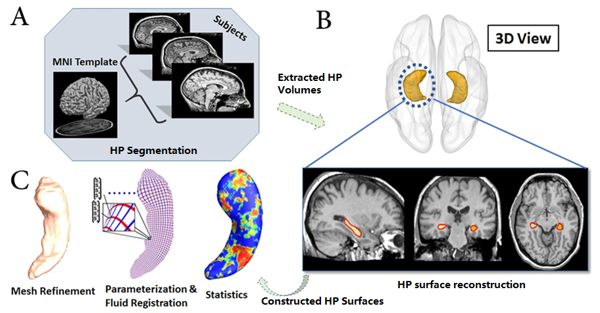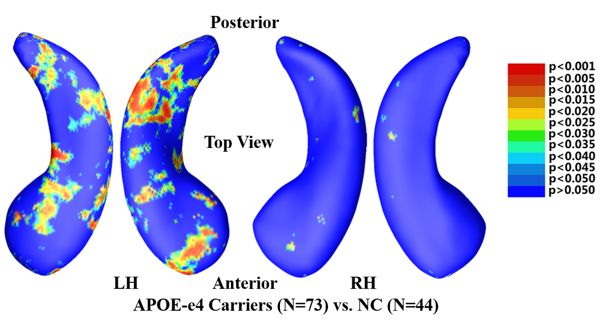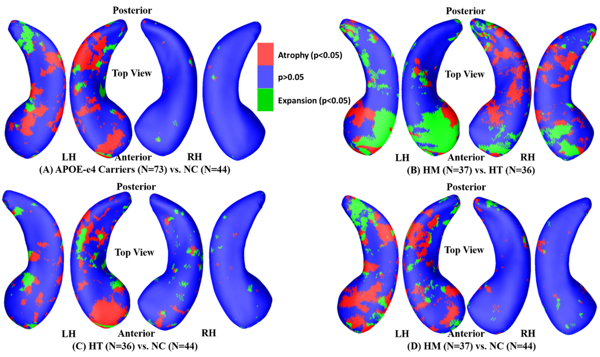Applying Surface-Based Hippocampal Morphometry to Study APOE-E4 Allele does Effects in Cognitively Unimpared Subjects
Qunxi Dong*, Wen Zhang*, Jianfeng Wu, Bolun Li, Emily H. Schron, Travis McMahon, Jie Shi, Boris A. Gutman, Kewei Chen, Leslie C. Baxter, Paul M. Thompson, Eric M. Reiman, Richard J. Caselli and Yalin Wang
(*Equal Contributions)
Abstract
Apolipoprotein E (APOE) e4 is the major genetic risk factor for late-onset Alzheimer’s disease (AD). The dose-dependent impact of this allele on hippocampal volumes has been documented, but its influence on general hippocampal morphology in cognitively unimpaired individuals is still elusive. Capitalizing on the study of a large number of cognitively unimpaired late middle aged and older adults with two, one and no APOE-e4 alleles, the current study aims to characterize the ability of our automated surface-based hippocampal morphometry algorithm to distinguish between these three levels of genetic risk for AD and demonstrate its superiority to a commonly used hippocampal volume measurement. We examined the APOE-e4 dose effect on cross-sectional hippocampal morphology analysis in a magnetic resonance imaging (MRI) database of 117 cognitively unimpaired subjects aged between 50 to 85 years (mean=57.4, SD=6.3), including 36 heterozygotes (e3/e4), 37 homozygotes (e4/e4) and 44 non-carriers (e3/e3). The proposed automated framework includes hippocampal surface segmentation and reconstruction, higher-order hippocampal surface correspondence computation, and hippocampal surface deformation analysis with multivariate statistics. In our experiments, the surface-based method identified APOE-e4 dose effects on the left hippocampal morphology. Compared to the widely-used hippocampal volume measure, our hippocampal morphometry statistics showed greater statistical power by distinguishing cognitively unimpaired subjects with two, one, and no APOE-e4 alleles. Our findings mirrored previous studies showing that APOE-e4 has a dose effect on the acceleration of brain structure deformities. The results indicated that the proposed surface-based hippocampal morphometry measure is a potential preclinical AD imaging biomarker for cognitively unimpaired individuals.
Figures (click on each for a larger version):
Related Publications
- Dong Q*, Zhang W*, Wu J, Li B, Schron EH, McMahon T, Shi J, Gutman BA, Chen K, Baxter LC, Thompson PM, Reiman EM, Caselli RJ, Wang Y, Applying Surface-Based Hippocampal Morphometry to Study APOE-e4 Allele Dose Effects in Cognitively Unimpaired Subjects”, NeuroImage: Clinical, 2019





